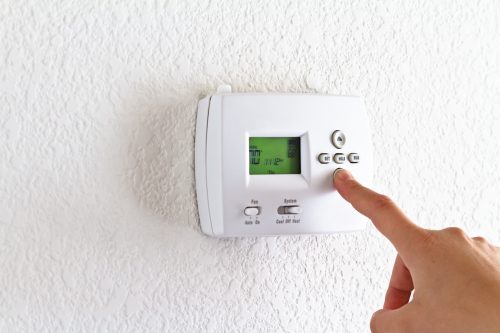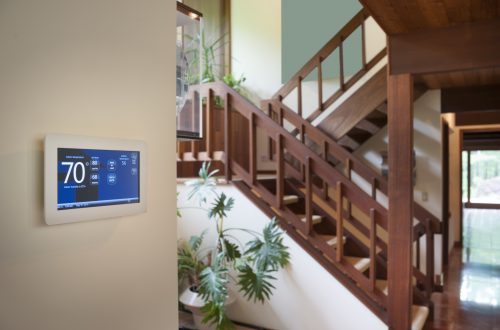Welcome to the Take Charge of Your Home series from Direct Energy! Hiring a professional to perform household maintenance may offer convenience and peace of mind. You can do many of these jobs yourself with no experience or special tools. In the process, you’ll save money, learn about how your home works and gain a sense of accomplishment. A DIY task done well!
Central heating and air conditioning are two of the most essential systems in many homes, and neither of them can function without a thermostat. Homeowners with the “if it ain’t broke, don’t fix it” outlook may have perfectly serviceable thermostats that are decades old. But in this age of smartphones and Wi-Fi, there’s a lot to be gained in upgrading your thermostat -- and who knows, your old faithful thermostat could finally bite the dust.
Diagnosing a Broken Thermostat
The most obvious reason to replace a thermostat is because it’s broken. Thermostat failure can sometimes be tricky to diagnose on your own, because you could also suspect problems with your heating and air conditioning systems. If you don’t have DIY experience with thermostats and HVAC systems, you may need the assistance of a licensed HVAC technician to affirmatively pinpoint the thermostat as the source of your problems.
Some of the most common symptoms of a broken thermostat include:
- The actual indoor temperature as measured by a separate thermometer is different from the temperature displayed on the thermostat
- The HVAC system doesn’t turn off when the temperature reaches the thermostat setting
- The HVAC system doesn’t turn on when the temperature changes from the thermostat setting
- The thermostat is unresponsive
- A battery -operated thermostat drains fresh batteries too quickly
Should You Replace Your Manual Thermostat?
Just because your old thermostat works doesn’t mean it isn’t costing you an opportunity to save money. Manual thermostats -- whether they’re digital or the old-fashioned analog dial -- can only be changed by a person interacting with them directly. But with a programmable thermostat -- or better yet, a smart thermostat -- you can exert greater control over your thermostat so that you’re not wasting energy maintaining temperatures that no one is home to enjoy.Advantages of a Programmable Thermostat
Digital programmable thermostats are comparable in price to manual thermostats and offer money-saving features, so there’s no reason not to choose this type as the minimum standard for thermostat replacement. Some features may vary from one programmable thermostat to another, but the primary feature is that these thermostats let you set different temperatures for different days and times. While everyone is at work and school, the thermostat can be set a few degrees lower in the winter and higher in the summer. Over time, the energy savings can more than pay for the cost of the upgrade, all while helping the environment the entire time.Advantages of a Smart Thermostat
The state-of-the-art option, though, is the smart thermostat. Smart thermostats can be controlled from anywhere in the world via smartphone or tablet apps. These apps make setting schedules easy and elegant, but whenever your plans change, you can take control with a few taps of your phone. There’s an even greater variety of features among smart thermostat brands, such as intuitive technology that “learns” your schedule and settings that respond to outdoor weather conditions.
Which New Thermostat Is Right for You?
Given the unparalleled features of smart thermostats, there are a lot of reasons to go big with your next thermostat upgrade. But smart thermostats aren’t necessarily the perfect fit for everyone. For instance, smart thermostats can’t function without access to wireless Internet, and they’re not practical for homeowners who don’t use smartphones or tablets. So if you don’t have both wireless internet and a smartphone or tablet, you’ll get much more benefit from a programmable thermostat.
Smart thermostats are more expensive than programmable thermostats, and if you pay an HVAC technician to have yours professionally installed, the installation costs could also be higher. It all depends on the existing wiring within your walls.
Another consideration is that smart thermostats aren’t compatible with all heating and cooling systems. If you have central air conditioning and heating or a heat pump, it’s likely that you’ll be able to integrate most smart thermostat models into your home. But if you have radiator heat, baseboard heaters, swamp coolers or other less common components in your HVAC system, there may be compatibility issues. You should check the product specifications of each smart thermostat you’re considering to make sure they’re compatible with the equipment in your home.
All that said, if you’re a smartphone user with wireless internet, a compatible HVAC system and enough money to purchase and install a smart thermostat, the savings potential of this technology is enough to pay for the cost of the upgrade over time.
Ready to replace a thermostat in your home? Choosing the right thermostat isn’t the only big decision -- you’ll also need to decide whether to install it yourself or hire a pro, which is what we’ll explore when we return with part two of this project.

